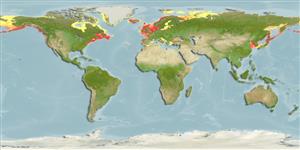Common names from other countries
Classification / Names / Names
ماع يماسا | فدارتم | Catalog of Fishes (gen., sp.) | ITIS | CoL | WoRMS
Environment: milieu / climate zone / depth range / distribution range
يسانش موب
; روش بل; قمع تارييغت 0 - 192 m (Ref. 78574), usually 0 - 25 m (Ref. 75831). Temperate, preferred 9°C (Ref. 107945); 77°N - 33°N, 180°W - 180°E (Ref. 113928)
Northwest Atlantic from Nova Scotia to Virginia, North Sea and European waters including the Black, Baltic, Wadden, White and Mediterranean seas, and northeast Pacific from San Francisco to Alaska.
Length at first maturity / Size / Weight / نس
Maturity: Lm ? range ? - ? cm Max length : 10.0 cm TL يسنج صاوخ نودب / رن سنج; (Ref. 7726); هدش شرازگ نس هنيشيب: 8 اه لاس (Ref. 2823)
Minimum depth from Ref. 101279. Maximum depth recorded is 329 m (Ref. 101279). Lives in burrows in sand, mud, sandy mud and sandy gravels from the mid shore to the shallow sublittoral, sometimes to a depth of 192 m (Ref. 78574). Commonly found in estuarine areas, buried in substrate 10 to 20 cm deep (Ref. 95344). In the Vainameri (north-eastern Baltic Sea), abundant in silty substrate (Ref. 95753). Deposit/filter feeders (Ref. 95728). Identified as an ecologically important benthic species of the Baltic Sea, mainly as part of the food base of fishes and its contribution to biofiltration and biosedimentation processes (Ref. 95774). A microvore that feeds on organic detritus (Ref. 96352). Found both in intertidal mudflat and estuary (Ref. 2823).
Life cycle and mating behavior
غولب | لثم دیلوت | یزیر مخت | اه مخت | Fecundity | )ورال ( دازوت
Members of the class Bivalvia are mostly gonochoric, some are protandric hermaphrodites. Life cycle: Embryos develop into free-swimming trocophore larvae, succeeded by the bivalve veliger, resembling a miniature clam.
یلصا ذخآم
عجارم | هدننك گنهامه | ناراكمه
Harvey-Clark, C. 1997. (Ref. 7726)
NCUI زمرق تسرهف رد تيعضو (Ref. 130435)
ستياس رظن زا تيعضو (Ref. 108899)
Not Evaluated
Not Evaluated
یناسنا هدافتسا
تاليش – يريگ يهام: يراجت
FAO - يرورپ يزبآ: production; تاليش – يريگ يهام: landings | FishSource | Sea Around Us
اهرازبا
يتنرتنيا عبانم
Estimates based on models
Preferred temperature
(Ref.
115969): 6.4 - 14.5, mean 10.9 (based on 360 cells).
یگدنهج
طسوتم, لاس 4/4 – 1/4 تيعمج ندش ربارب ود يارب مزال نامز هنيمك (K=0.14-0.48; tmax=8).
یريذپ بيسآ
Moderate vulnerability (39 of 100).
